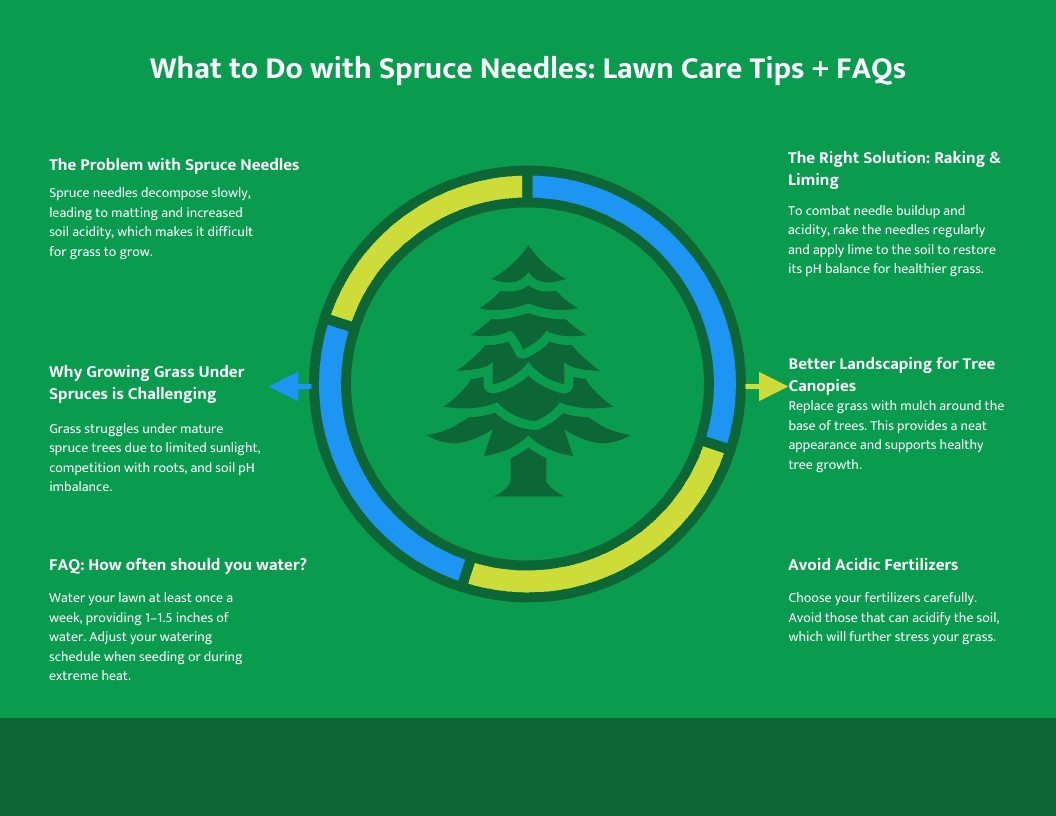TL;DR
- Spruce needles decompose slowly and can smother grass and acidify soil.
- Rake them regularly and add organic matter to improve soil health.
- Lime the soil if it’s too acidic, and avoid acidic fertilizers.
- Grass struggles under mature spruce trees—mulch those areas instead for a cleaner look.
I got another interesting question recently. We handle tree care as well as lawn care, and you’d be surprised how much overlap there is.
“Spruce needles (lots of reddish brown needles) have fallen from very old trees onto my lawn, the trees cannot be saved, but what do I do with the lawn? Can I leave the needles or do I have to remove them?”
Evergreens drop some needles annually as part of their growing process, especially when they are old or sick. This is a problem for turfgrass because when the needles break down, they cause a “matting effect” in the soil bed surrounding the tree causing difficulty for turf (or most plants for that matter) to grow well. “Matting” means that the needles, which are slow to decompose, are layered with pockets of air and no real soil, leaving nothing to properly root into. In addition, they can contribute to making the soil more acidic.
Once the pH of the soil starts going down, it is very difficult for the grass to absorb nutrients. That’s one of the main reasons why you never see really healthy grass underneath pines and spruces.
You can improve the situation with regular limings – that will help bring the pH back up. you can also try to rake up the needles to reduce the matting effect, and adding a small amount of organic matter by way of topdressing to help. But you need to remember, growing grass under the canopy and shade of any mature tree, and competing with its root system is really difficult if not impossible. You will never get the grass under your evergreens to look as nice as the rest of your lawn.
Another fix would be to find a more suitable landscape idea for underneath trees, try just mulching under the base and the outer perimeter of your trees. That way you could have thick, lush grass up to the drip-line of the trees with a clean transition to attractive wood mulch. Much nicer than your lawn just petering out in sickly-looking tufts.
**Another point to remember: Poor fertilization choices can cause soil to become more acidic over time, so it very important to know your soil and choose the right fertility program for your lawn- not just any off the shelf package with good marketing!
When it comes to tree care we can also assist with magnolia tree scale as well.
FAQ About Best Lawn Care Practices
🌱 How Many Times a Week Should You Water Your Lawn?
You need to water at least once a week for at least an hour, this generally provides 1-1.5″ of water to the roots (a tuna cans height) (exceptions: 1. when you seed & 2. if you have an automated system 3. When we are experiencing extreme heat).
New Seeding Watering: Seed must be kept moist until established. This will be influenced by the amount of sun, wind and heat you are experiencing in your particular area. It is normal to require 3-4 short waterings per day to maintain a moist seedbed. Use a light stream of water to lessen disturbance of the seedbed.
🌱 Why Is My Lawn Bumpy?
There are a number of reasons why lawns get lumps and bumps in them. The continual freezing and thawing over spring can cause soil to shift unevenly. Wild animals or pets can dig up areas of a lawn. Even walking on it when it is too soft either in the spring or after a very heavy rainfall can cause depressions to form in your lawn. If lumps and bumps in your lawn are concerning you it is best to contact a qualified lawn care specialist near you to diagnosis exactly what the issue is and the best way to deal with it.
🌱 Should I Mulch My Lawn?
2 inches of mulch naturally retains moisture, offers a neat appearance and greatly reduces the amount of weeding. Keep mulch a couple of inches away from the base of trees. Freshen your mulch with a quick cultivation once or twice a year. There are several varieties available, from Cedar to Cocoa bean, Wood Chips, Bark etc. do NOT use dyed wood mulch, it can cause problems if they are chemical based dyes that leach and injure sensitive root systems.







